You might not think much about picking up your dog. For some, they are so large it’s a rare occurrence. For others with smaller dogs, you simply pick them up without much thought. But is there a proper way to pick up a dog? Certainly.
In this article, we will go over how to pick up a dog according to its size—and give you a few other tidbits of useful information.


How To Pick Up A Dog Properly
1. Consider the Size of Your Dog
Before you get started, you need to think about the size of your dog and yourself! We all have our own weight limitations. It’s perfectly okay if you cannot lift your dog or need help doing so.
If you have a smaller dog, it’s likely that you already pick them up as is. You might just want the appropriate methods to lift them, creating the most security.
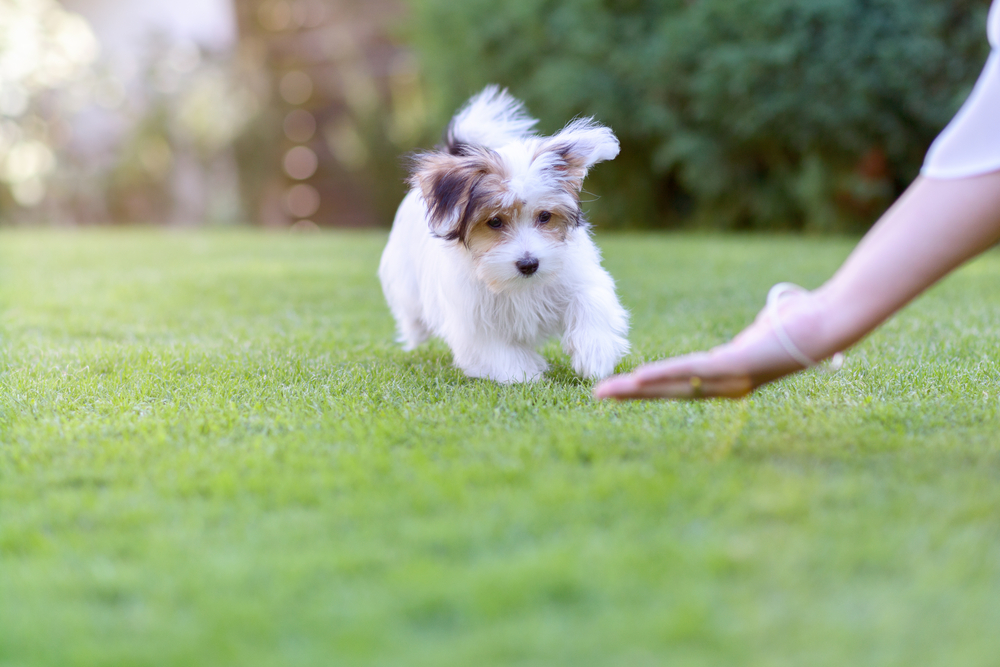

2. Assess the Benefit of Picking Up Your Dog
If you just want to pick up your dog for a cuddle, that can be fine for the most part. However, if you’re in a situation where you need to lift your dog into a vehicle, onto a boat, or away from harm, you’ll need the quickest and safest method to do so.
Some dogs are naturally rambunctious. If you try to pick them up, they’ll likely fidget and thrash around, resulting in potential injury if you’re not handling them correctly. The bigger the dog is, the more problematic it can be. It may be a better option to train them to use a step or a ramp when needing to get to higher levels – this helps save their back, and yours!
3. Choose the Appropriate Way to Pick Up Your Dog
There are lots of methods to pick up your dog depending on factors like size, temperament, and the situation.
Some of these methods include:
When it comes to teeny puppies or teacup sized creatures, you probably pick them up regularly already, and likely, with this technique: Use your dominant arm to scoop your dog over the chest and then gently cradle the chest in your hand. Tuck their back end against your body using the forearm. This is perfect for dogs under 9 lbs. This is the only holding method that only needs one arm, leaving you to keep your dog calm with some pats, or hold a second one!
For the ribcage lift, you need to place one hand under the dog’s rib cage just behind the front legs. To secure that hand, cuff it around the elbow of the front leg on the farthest side. Then, put your other arm over the top of the dog’s body, just around the back of the hind legs, tucked in behind the knees
In this position, your entire hand should be around the rib cage. Hold the dog close to you and support your dog’s body closely to yours.
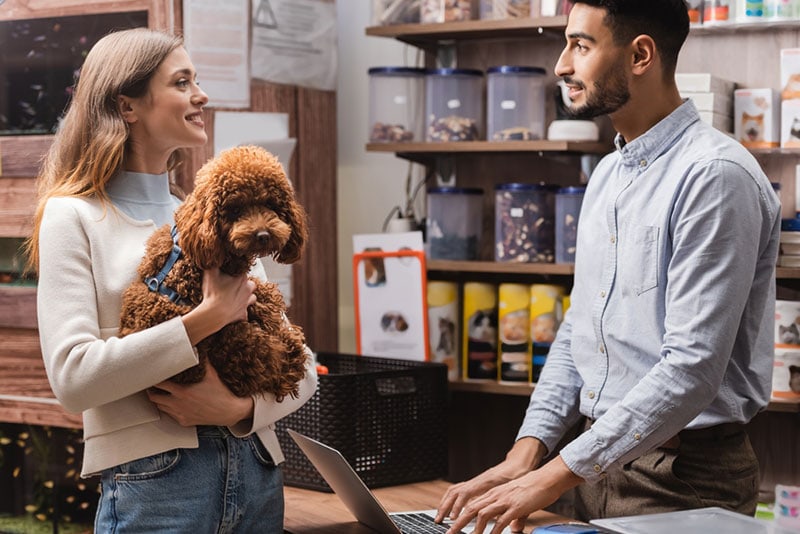

This is a great option for lifting medium to large dogs up (but we wouldn’t recommend carrying them around for very long!) or for dogs with back pain or injuries. Ideal for dachshunds following a spinal injury or surgery.
Place both arms out, bent at elbows, palms up. Depending on the size and temperament of the dog, you can scoop them up with arms around the front of the front legs, back of the back legs, or back of the front legs and in front of the back legs, or any combination of the above. The aim is to keep the dog calm, their back straight, and spread their weight across both your arms.
Remember to always lift with your knees and not your back, as you could pull a muscle or damage your spine.
4. Implement Safety
When picking up any dog, safety should be your top priority. If you are training a dog and need full control, you should get a harness with a control handle. While there are better methods to pick them up, it can assist you in doing so, evenly distributing their weight.
If you are picking up a dog that is injured or in pain, be aware that they may bite. Using a muzzle is advised in this situation.


5. Get Additional Support, If Needed
If your dog is too big for you to lift yourself comfortably, it is imperative to get a helping hand. Attempting to lift the dog anyway could injure both of you. If you need to lift your dog but can’t do it alone, it’s best to ask a friend, family member, or another party to help you out.
If you are picking up a dog with the help of someone else, make sure both of you are cradling the appropriate areas and making your dog comfortable in the process.


What NOT To Do When Picking Up Dogs
Now that you know how to pick up a dog safely, here are some absolute “no” methods.
1. Don’t Lift a Dog By the Collar
Most adults understand that you should never pick up a dog by their collar, but children might not be so well versed. It isn’t as unusual to see a child trying to mishandle a dog, as they don’t know the proper means of doing so yet. That is why as parents, it’s crucial to teach them proper methods.
The collar fits around the most sensitive part of your dog’s body, its neck. Using the collar as leverage to pick up your dog can lead to severe injuries in the neck—and even death, in worst-case scenarios.
Your dog has very sensitive portions of the neck, including the throat, trachea, esophagus, and larynx. If you pick up a dog by the collar, you eliminate its air supply and strain these delicate organs.
If you have ever heard any dog health expert talk, they might have recommended harnesses instead of collars. That is because walking your dog on a collar can do some severe damage over time, especially if your dog pulls or you yank on the leash.
Harnesses are better at equally distributing the weight, putting the pressure instead on the bulbous base of your dog’s chest rather than the sensitive parts of the neck.
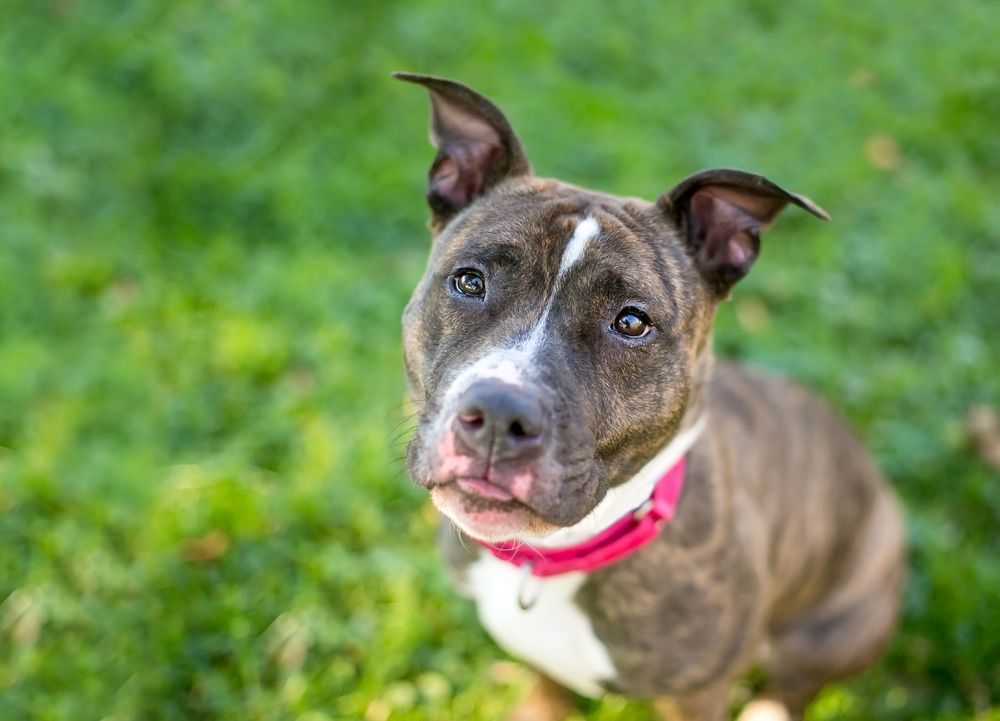

2. Do Not Hold Arms or Legs
It is very normal for a small child to want to lift a dog up by the arms. If you aren’t very acclimated to picking up dogs, this might also be a method you would think to use.
However, this is a very sensitive part of the dog’s body, and you should never try this method, no matter how small they are. The goal is to ensure your dog’s weight is evenly distributed so it does not put pressure on any sensitive joints or bones.
If you pick up a dog by the legs, it can cause dislocation, damage to ligaments or tendons, and muscle strains. If you try to pick up an older dog by the legs, it could even worsen or inflame existing arthritis and lead to extreme pain.
3. Do Not Grab Scruff
We’ve all grown up understanding that mother puppies and even cats pick up their young by the scruff. You might think this is completely safe for you to do as well, but you couldn’t be more wrong.
The mother animal knows exactly how to transport their offspring. This method of carrying is only meant to work for very small puppies. However, once the dog develops, this is no longer a suitable way to pick them up at all.
A puppy turns from being palpable and flexible to more rigid and structured. Plus, a dog is much more likely to resist if they are being grabbed by the scruff rather than giving in. This resistance can cause severe injury to the neck, spine, and other internal structures.
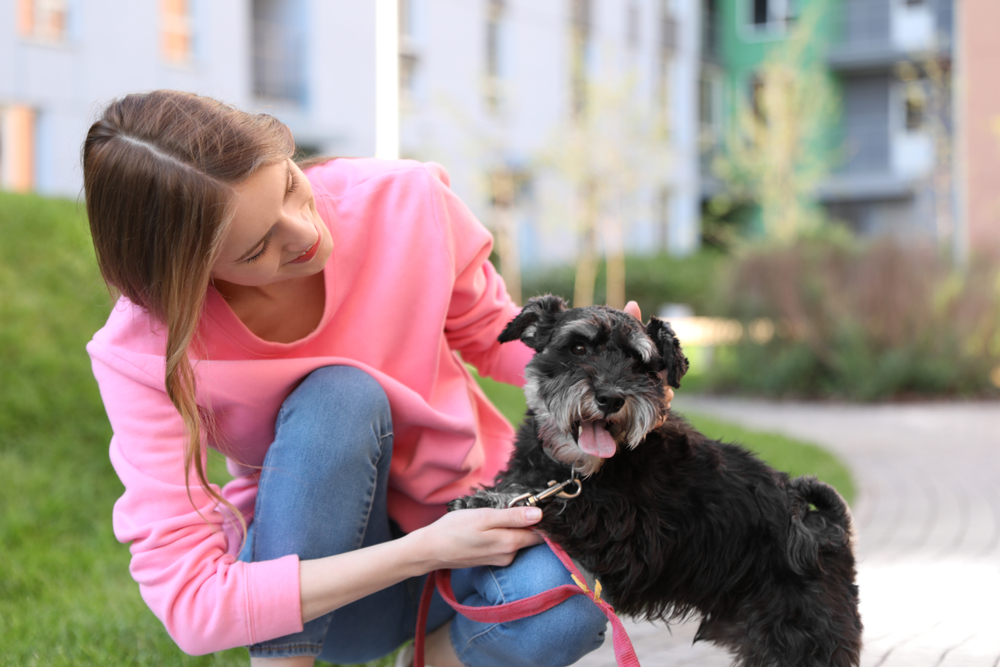

4. Do Not Grab the Tail
Even though the tail seems like a pretty good handle, never ever pick your dog up, putting any pressure on it whatsoever. The tail is full of bones, and when you apply weight and pressure, you can break the tail and strain the back also.
Your dog’s tail is full of nerves and muscles. If you yank a dog up by its tail, you could severely injure all of these components within the tail, ultimately causing difficulty controlling movements and even incontinence.
That means that if your dog is damaged when you pick them up by the tail, it can lead to trouble using the bathroom properly. They might be unable to empty their bowels or urinate correctly, causing accidents in the house and decreased quality of life.
Just remember, the tail is a no-no.


Picking Up a Dog Based on Size
Now that you know the proper methods of picking up a dog, here are some additional tips based on size alone.
1. Toy/Small Dogs
You probably pick up your small dog without even thinking about it. But we want to make sure you understand that dogs between 3 and 20 pounds still need to be comfortable with handling.
When you pick up your small dog, you need to cradle them under the chest and pull them close to you, in a football position. This is very easy to do with smaller dogs, but the more they weigh, the more support you will need from both hands.


2. Medium Dogs
Medium dogs generally weigh between 30 and 70 pounds. Your ability to pick up a dog in this range will depend on your overall body size and physical capabilities. You might be very comfortable lifting a dog between 30 and 45 pounds but struggle to lift beyond that.
If you have trouble lifting a dog of that size, ensure you have someone around to help you avoid injury.
3. Large/Giant Dogs
A large dog is any that weighs roughly 55 pounds and above. These dogs almost always require a second person for lifting purposes. If you try to pick up your dog by yourself, you could cause you and them some serious problems down the line.
Also, if you drop a very large dog, this could cause severe pain and long-term injury. We highly recommend a duo in this weight range.
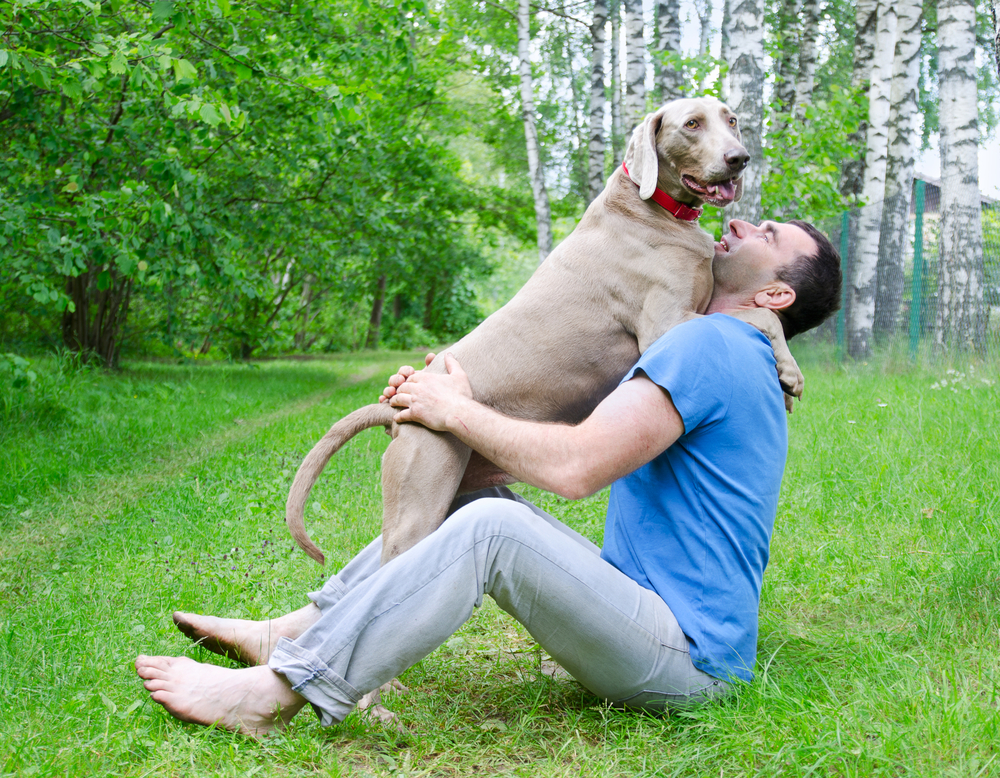



When Should You Lift Your Dog?
Unless your dog is a very small, cuddly lap dog, you likely won’t be lifting them very often. After all, our dogs are very agile and can jump onto numerous surfaces themselves. So in what situations might you lift your dog?
1. Immobility Factors
As our dogs age, their bodies begin to slow down and deteriorate. Their connective tissue and bones don’t work together like they used to. If your dog has any type of mobility issue, including arthritis, they might need your help doing what once might have been a simple task.
If your dog has mobility issues, it’s best to ensure you are handling them as safely and efficiently as possible. Mishandling can result in further injury, leading to long-term problems, including partial or total paralysis. Slings and mobility harnesses can be useful if your dog has a chronic condition or is recovering from surgery, otherwise, using a towel under the tummy to give them additional support can be helpful.
2. Sudden Safety Risks
Let’s just say you and your dog are out taking a walk. Another aggressive dog comes up, or your dog is about to charge into oncoming traffic. In these quick, dangerous scenarios, you need to make sure you can lift your dog safely to keep them protected.
Hopefully, you never have to use any method to pick your dog up for this reason. But it’s always nice to know exactly how to pick up your particular dog in crucial moments.


3. To Reach Vet/Grooming Table
When you go to the vet or groomer, you might assist your dog up on the examination table or workstation. If so, you need to know how to lift them appropriately, getting them to the level they need to be.
4. Situational Control
If your dog is being particularly rambunctious or requires restrictive handling, you might have to pick them up momentarily to get them to a calmer situation.
For example, if your dog gets very excited to see a squirrel or cat running around the neighborhood, you might need to pick them up if they are pulling at the leash or refuse to calm down. Once you pick them up, you can get them to a place where they don’t have that same stimulation.
4. Injury
If you are hiking or walking, and your dog gets hurt, you might need to carry them back to your vehicle. In the event your dog is injured, you must be very mindful of where you’re handling them so as not to make the injury any worse than it is. And remember that even a placid dog can bite if they are in pain. If you need to lift a dog that is in pain and don’t have a muzzle handy, place a towel or jacket around their head (not tightly!) to give you a bit of a buffer zone.
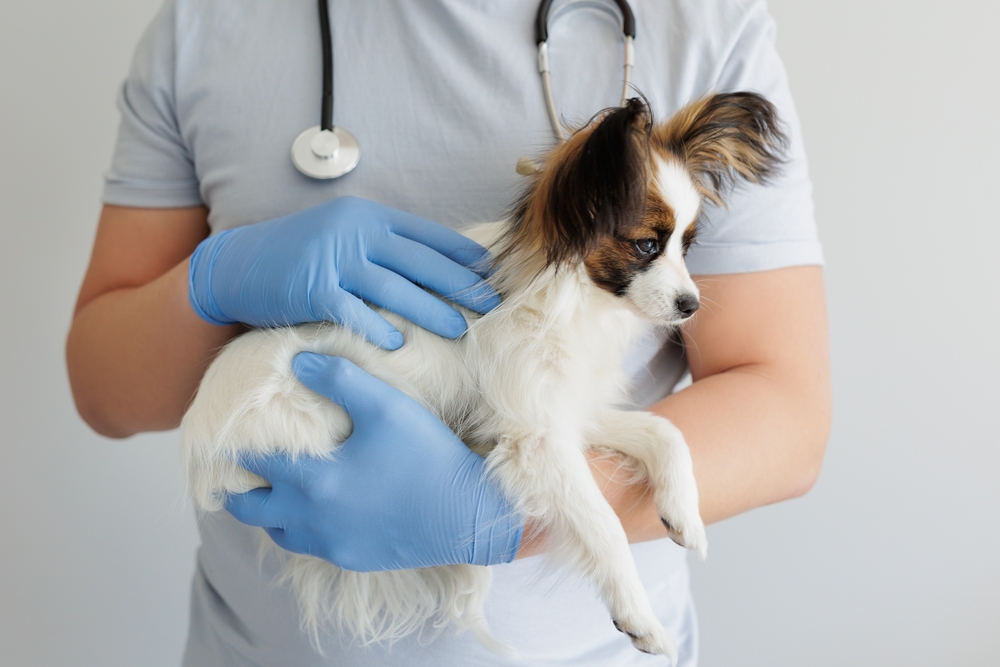

5. Fatigue
If you have a very small or elderly dog, they might get tuckered out quite easily. If you’re out somewhere where you can’t take them to relax at that moment, you might need to carry them to your destination or even back to the vehicle.

Alternatives to Holding Your Dog
Instead of carrying your dog around, you can also get a backpack or even a stroller to take them where you wish. These methods can be a lot easier and tire you less as well.
1. Backpacks
Backpacks work best for toy-to-medium-sized dogs. It would be best if you never carried any dog over the weight limit you feel comfortable with. Because of certain health conditions or restrictions, you might have a limit, and that’s perfectly okay.
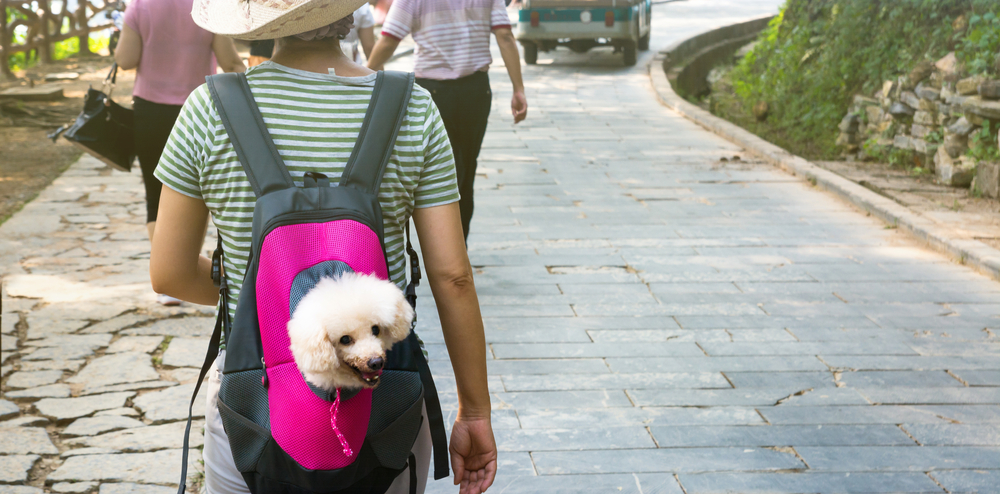

2. Stroller
An alternative to a backpack would be a stroller or a pull-behind. You can get a pet stroller at virtually any online pet shop or some pet stores. Unlike baby strollers, these strollers are designed to enclose your dog so they cannot escape. They also have safety harnesses inside to add an extra layer of protection.
These are great for older dogs who still want to get out and about but can’t keep up with the others, or for young puppies to start experiencing the world, but haven’t had all their vaccinations.
3. Ramps
If you’re trying to get your dog to jump up on the sofa, but they don’t really seem able to do it like they used to, you can always buy a ramp. Ramps can also work really well for small dogs that can’t quite make it up to your bed.
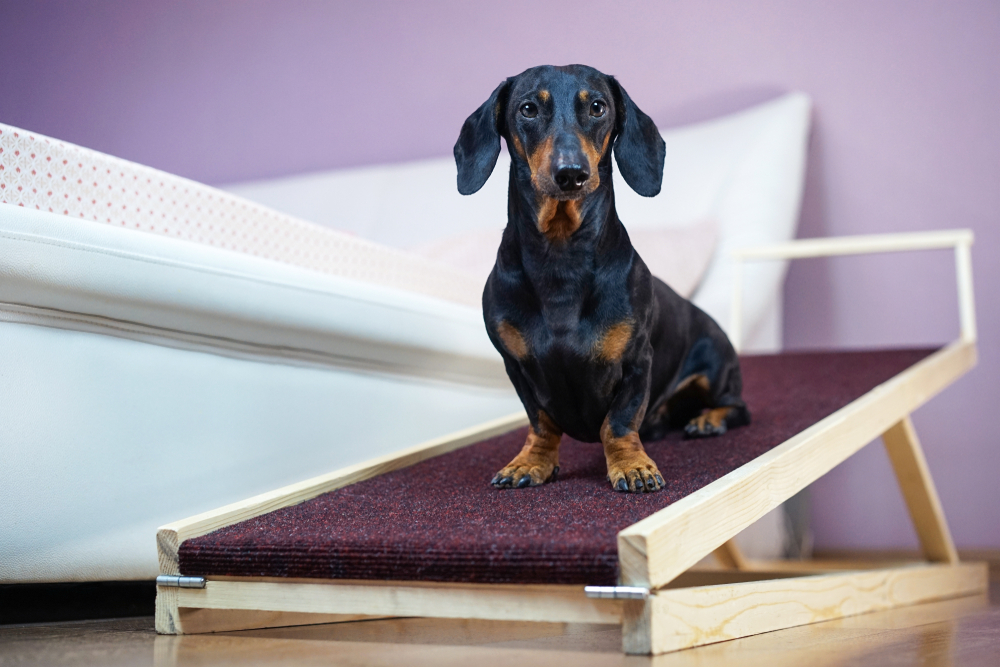



Conclusion
Now you know how to lift your dog safely. Whether you have a toy breed or a giant breed, you need to know how you will handle them and a situation where lifting is required. Only lift what you’re comfortable with as well. The last thing you will want is to injure yourself or your dog in the process.
If you need a helping hand, always ensure someone is on standby to assist you with the lifting process. Instead of carrying your dog to various places, you can also get something to help you out with that, such as a backpack or stroller.
Featured Image Credit: Alina Kruk, Shutterstock
